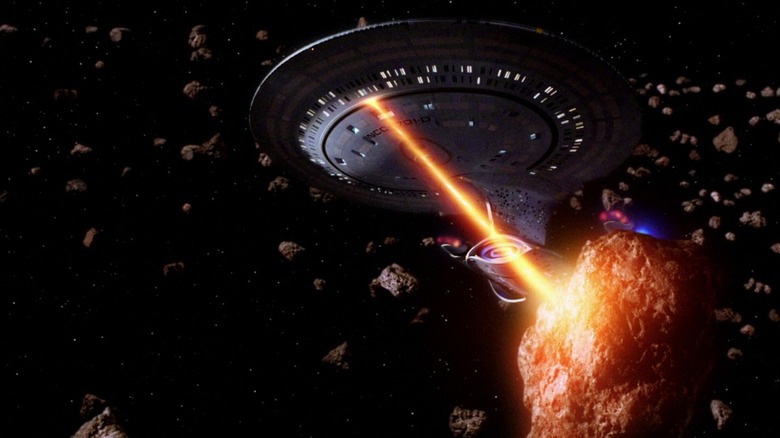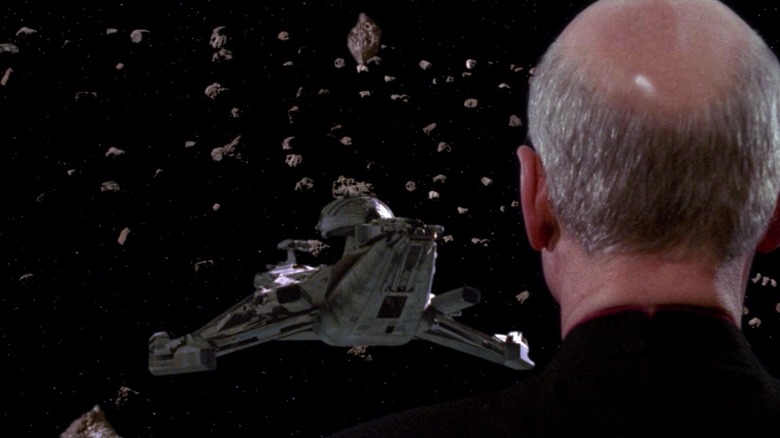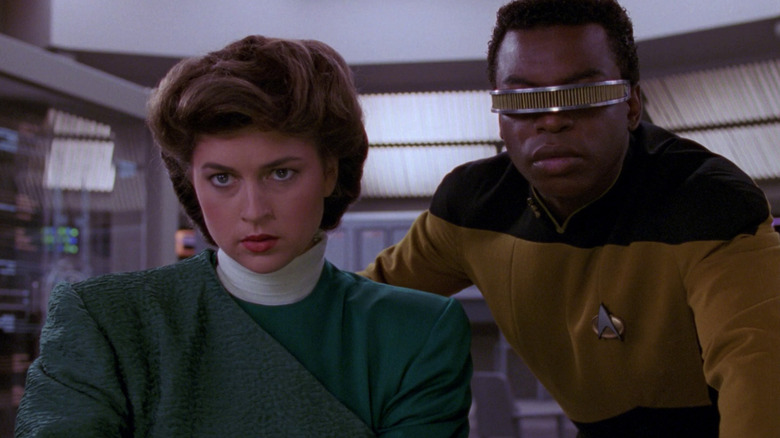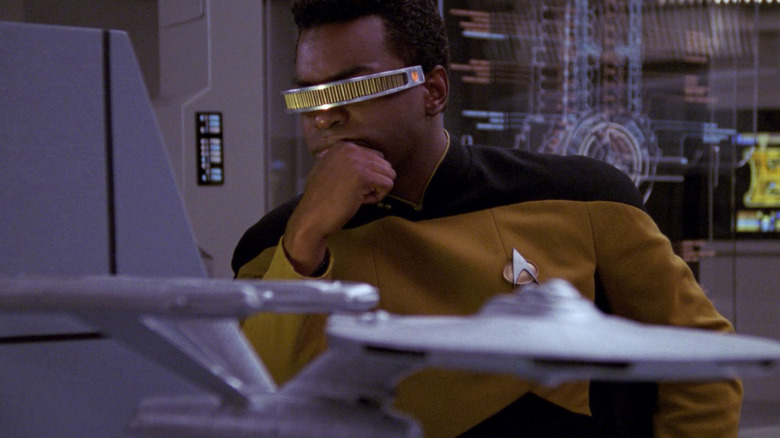Star Trek: TNG's Booby Trap Put The Enterprise In A Classic Trek Problem
In the "Star Trek: The Next Generation" episode "Booby Trap" (October 30, 1989), the Enterprise-D discovered — floating in a vast asteroid field — an ancient Promellian battle cruiser, a ship that had been built 1,000 years earlier. Captain Picard (Patrick Stewart) mentions that the cruiser was engaging in space battles when Earth was barely perfecting the crossbow and that he — an archaeology buff — used to build models of similar ships as a boy. The Promellians, he explains, were once engaged in a costly and prolonged war with a species called the Menthars. The Promellian/Menthar war entirely wiped out both species a millennium ago, and derelict ships from the conflict are quite rare indeed.
"Star Trek" typically espouses a pointed pacifist philosophy, but one might find that the franchise also contains numerous characters who are fascinated by the history of combat and antique weapons of war. It's telling, however, that a battleship is merely a disused artifact in this universe.
When the Enterprise approaches the Promellian battle cruiser, however, all of its systems begin to randomly shut down. The power is draining from the ship and no one knows why. The engines shut off and the Enterprise is stranded. Communications go down, leaving them unable to call for help. Most notably, the shields drop, letting in lethal doses of mysterious localized radiation. If the Enterprise cannot escape, the crew will die and the Enterprise will be left derelict as well.
Only Geordi La Forge (LeVar Burton), the ship's engineer, can solve the problem.
Technology
"Star Trek" is, of course, set in a far-off future where technology is friendly, widespread, and used to benefit the quality of life throughout the galaxy. Starships are equipped with weapons, of course, but most of the shows' stories center instead on their propulsion, communication tech, food replicators, shields, and holodecks. Society has adapted to advanced technology and has become reliant on it. "Booby Trap" presents Trek's future society with a major problem: What happens when said tech fails on you? And how does an engineer — a man who lives for technology — solve a problem with as little tech as possible?
This is a classic "Star Trek" conundrum, one that forces characters to question the role of technology in their lives. We can rely on it, yes, but "Booby Trap" proves that it may not always be reliable. Sometimes, Geordi will eventually discover, a more human touch is required.
By the show's third season, the writers of "Star Trek: The Next Generation" developed a clever teleplay-writing template that allowed them to broadcast their theses in the very first scene. At the start of "Booby Trap," Geordi is seen on the holodeck with a woman named Christy (Julie Warner). They're on a date, and it's not going well. Geordi has used his engineering acumen to program the perfect simulated beach scene, the perfect simulated drinks, and a simulated itinerant violin player. Christy rejects all of it and leaves the date, claiming fatigue. All the technology in the world couldn't help Geordi generate honest romance.
Audiences see right away that technology will not be the answer. That theme will lurk in our minds for the rest of the episode. Kudos to credited screenwriters Ron Roman, Michael Piller, and Richard Danus.
Dr. Leah Brahms
The Enterprise crew eventually discovers that an ancient booby trap had been set for the Promellian battle cruiser, a booby trap located in the nearby asteroids. The trap sucks energy out of a ship, then redirects it back as harmful radiation. Any energy expense is almost instantly drained. Geordi has to find a way to speed up the ship's energy relays so that he can power the engines before they can be drained. In order to study the engines that closely, though, he has to study the way the Enterprise looked right when it was built; in the last few years Geordi has made a lot of engine alterations on the fly.
Geordi, then, recreates the design lab where his ship was first conceived on the holodeck. To help him out, he creates a simulated co-worker in the form of Leah Brahms (Susan Gibney), the Enterprise's chief designer. Geordi and the simulated Leah brainstorm incessantly and come up with several possible solutions, but each one fails. When things look dire, they have their Eureka moment. If they shut down every system on the ship — including life support — and fire the Enterprise's thrusters for a short burst, they can use mere gravitational inertia to drift out of the asteroid field. Sometimes, Geordi says, you have to shut it all down.
It wasn't technology that solved the problem, but a basic knowledge of physics. Indeed, Picard — eager to contribute — ends up piloting the Enterprise himself, steering it out of the asteroids, and even harnassing the gravity of one of the larger asteroids, to slingshot the ship to safety.
The fate of the cruiser
Many Trekkies have noticed a glaring issue with the denouement of "Booby Trap," however. Once free of the radiation field, the Enterprise is instantly able to power back up again. Picard got to harness gravity like an old-school space sailor, Geordi learned a lesson about reliance on technology, and even fostered a romance organically; it wasn't about creating a simulated environment, but developing a mutual passion for his organic interests (in the case of Geordi and Dr. Brahms, engineering). And, yes, the irony of the episode is that Dr. Brahms herself is a simulation. That simulation, incidentally, will get Geordi in trouble when he meets the real Dr. Brahms in season four.
The glaring issue, though, is when Picard says to Riker (Jonathan Frakes) that no one should be drawn in by the Promellian battle cruiser again. Riker orders that the ship be destroyed, and Worf (Michael Dorn) blows it up. Many viewers winced at the ship's destruction. It is, after all, a 1,000-year-old relic left over from a lost civilization. Surely it should be preserved for valuable anthropological research. Indeed, wouldn't the archaeology enthusiast Picard want to keep it intact? Why can't they put out a warning buoy instead of destroying the whole ship? It feels like a massive waste.
But considering the symbolism of the Promellian ship, destroying it made sense thematically. It was a holdover from a destructive ancient war, still possessed of the ability to kill. In a pacifist "Star Trek" universe, such a ship has no function. The memory of war is being destroyed, and battlefield technology is being put aggressively in the past. Practically, the Promellian ship should have been preserved. Dramatically, it made perfect sense to blow it up.



